| Hyde
Park |
|
|
|
| We entered Hyde Park
from the North, checked in at the registration booth as the sky turned
from black to deep blue, and wound our way down the Serpentine to the area
where the veterans line up for the start. Each car is backed into its
assigned place… which, in some cases, is easier said than done, since
the lack of a reverse gear means this becomes a manual operation. |
|
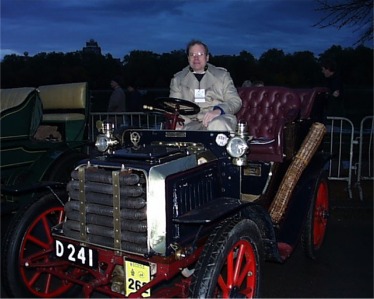
Above: Don, Darracq,
Dawn
|
| Some of the motors
in front of us sounded like lawn mowers that were targets for firecrackers
thrown by neighborhood kids. Others behind sounded like tambourines
irregularly slammed by lead pipes. Bill and Mary’s Darracq, by
comparison, purred confidently. |
|
| Or so I thought, as
Bill backed into his assigned spot. Bill, you see, is hardly ever
satisfied by his car’s performance. His ear for “something sounding
not quite right” puts one in mind of that princess who could feel the
lump created by one pea under fifty mattresses. |
|
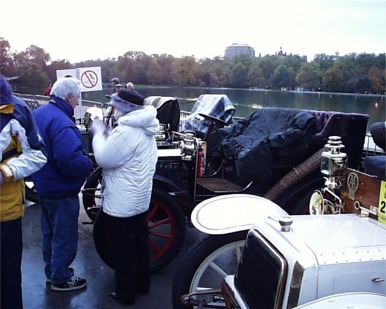
Above: Mary Ellam
stands on rain-slicked
Hyde Park pavement .
|
| Bill’s
perfectionism aside, the Ellam’s Darracq seemed extremely well-suited
for the run. It's beautiful, powerful (relatively speaking, of course)…
and even has a reverse gear. A single door in the center of the rear of
the car gives access to the passenger compartment, where there are two
side-facing rear seats. The seats are cozy - not in the traditional sense
of warmth, mind you - but for comfort and security, they can't be beat. |
|
| From this honored
vantage point, I surveyed the scene. Rumbling past us was the oldest car
in the run, an 1875 Grenville. This vehicle looked like a cross between a
steamroller and an early railroad engine. The Grenville (which
successfully completed the run at an average speed of 12 m.p.h.)
would be the first to leave the start line at 7:30 a.m., since the
oldest cars leave first. |
|
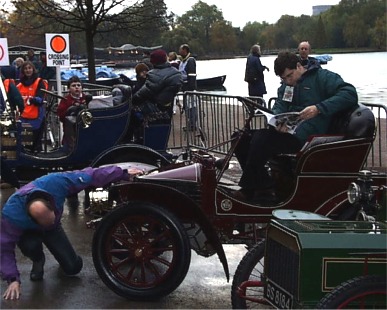
Above: A quick
pre-Run Check
|
| This “oldest
first” rule creates a benefit enjoyed by those who have an ’03 (like
Bill and Mary’s Darracq) -- the opportunity to begin ahead of the
‘04’s. This year, there were nearly 150 ’04 cars.
By the time we had settled comfortably into our spot, we had
perhaps forty minutes until our start time. |
|
| Somewhere behind
us… about 134 cars or so to the West… another Darracq – Genevieve
herself – must surely be backing into her place in the midst of the
other '04's. Bill Ellam, ever gracious, handed me a cup of coffee, pointed
me in the proper direction, and cautioned me to be back with a little time
to spare. |
|
| Genevieve |
|
|
| I walked westward
for a few minutes… and there she was. |
|
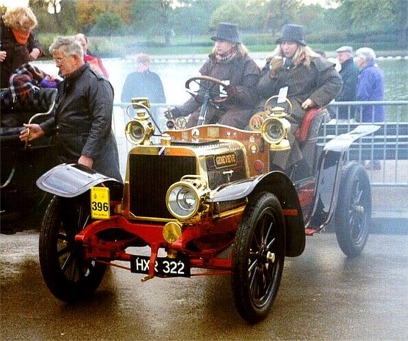
Above: Genevieve at
the start of the2000 Run - Driver Quirina Louwman and her sister Anisa.
Photo: David Burgess-Wise
|
| Number 396 in this
year’s Run… her license plate still HXR 322, just as seen in the film. |
|
| She looked every
inch a movie star, as did the two beautiful young women who would take
her from London to Brighton that day, Quirina and Anisa Louwman. Their dad
Evert would be driving another veteran from the Dutch National Motor
Museum in the 2000 Run, a four cylinder 1904 Mors. |
|
| Genevieve was
surrounded by a seemingly endless line of her 1904 contemporaries. Nearly
all of these have been restored to closely approximate their look when
new. Had this approach been taken with the restorations performed on
Genevieve post-1953, the car as seen in the film would no longer exist.
Happily, there is nearly universal agreement that this “mascot of the
old car movement” should look as she did in the film, not as she did
when sold to her first owner. And she does. |
|
| Genevieve is still a celebrity, causing heads to turn and photo flashes to fire. The
Louwmans seem to genuinely enjoy the attention that’s paid to their car,
and they have a keen appreciation for the sentiment many onlookers have
for Genevieve. As one of a handful of “cross-collectible” cars that
have a following and provenance from both the world of film and the world
of automobiles, Genevieve is a treasure… and she looks it. |
|
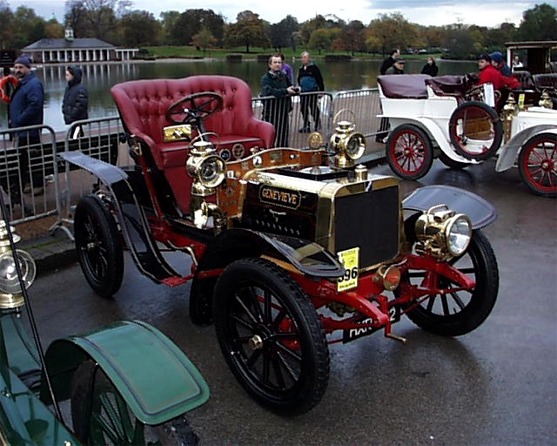
|
| “The car is in
excellent condition. It was in Australia for many years, and it’s only
been back in Europe for…” Evert Louwman turns searchingly to his
daughter Quirina, sitting in the driver’s seat of Genevieve. “…
what, five years?” |
|
| Quirina nods assent. |
|
| “Every year…
we’ve done the London-Brighton, as it is such a popular car,” Mr.
Louwman says. He gazes lovingly toward Genevieve, and his smile
encompasses pride in his daughters as well. |
|
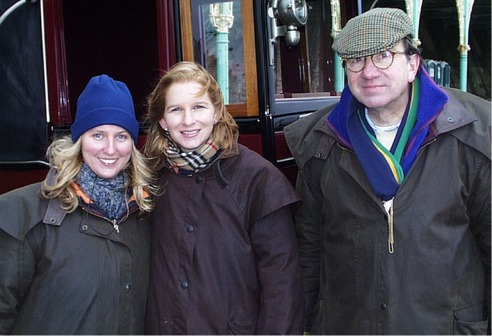
Above: The Louwmans:
Anisa, Quirina, Evert
|
| But – with the
threatening weather – isn’t he just the least bit worried about Genevieve? |
|
| “No… my daughter
is doing very well with the car. I have no worries at all. And in England,
they’re so polite, they’ll give way to my two girls… and to Genevieve.” |
|
| Quirina has driven
this route before. “This is my third London-to-Brighton Run,” she
reports. The most important differences in driving a veteran car?
“Brakes. You have to think ahead. And you can’t keep your foot on the
clutch, or you’ll burn it. The gears and the clutch are the biggest
differences.” |
|
| I’m introduced to
the Museum’s curator and ask if anything special is done to prepare
Genevieve for the run. “Basically, we put petrol and oil in her and
she’s ready to go,” he replies. “We’re very happy with the
condition of this car.” |
|
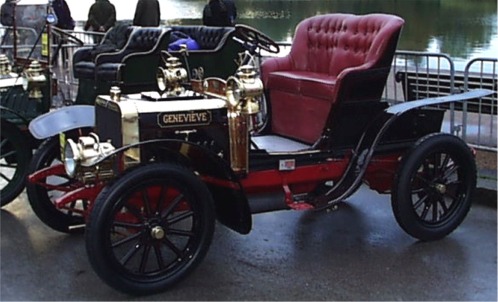 |
| Judging by the
gathering crowd, England is equally happy to have Genevieve back in the
event she made famous. |
|
| Mr. Louwman headed
back to his Mors, Entry Number 404, which would depart around the same
time as Genevieve, Number 396. I realized that I should be rejoining Bill
and Mary, because if the driver of Number 404 is gearing up for the
approaching start, the passenger of Number 262 should definitely not be a
hundred and thirty-four cars away from his “ride.” I walked East, from
1904 back into 1903. |
|
| Click
Here to go to Next Page |
|
|


